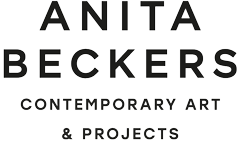POSITIONS Berlin 2021
Viviana Abelson, Kota Ezawa, Annegret Soltau & Susa Templin
09.09.2021 – 12.09.2021

Viviana Abelson, Legend, 2019, tires, rubber and metal, 220 x 130 x 70 cm, unique piece
Inquire
Viviana Abelson (*1985 in Buenos Aires) was a master student with professor Douglas Gordon at Städelschule in Frankfurt am Main. In her work she uses massive, heavy, rough and sturdy materials, which are difficult to handle. Her powerful sculptures and objects are not aiming at aestheticism, but nevertheless have a subtle beauty. She plays with the appearance of surface structures, sometimes seemingly destroying the materials she uses. Through burning, stretching, cutting and reassembling readymade objects she creates an air of bewilderment and familiarity in her work. The energy she inflicts on the pieces during the process of construction seams to surround the presence of the works like an aura.

Kota Ezawa, Kniefall von Warschau, 2020, lightbox, 76,2 x 106,68 x 6,98 cm, 5 + 2 AP
Inquire
Kota Ezawa (* 1969 in Cologne) is a German-Japanese artist living in San Francisco and Berlin. Ezawa reworks mostly found images of pop culture, film and art history by reducing them to flat digital images. To do this, he removes superfluous details and deliberately opts for a simplified version that is easy to recognize but remains powerful. This is the result of a preoccupation with human visual memory and behavior and their influence on the viewer. With regard to his art, Ezawa is particularly interested in the way in which images influence our experience and shape our personal and collective memory. His work is interdisciplinary and finds its form of expression in different media.

Annegret Soltau, Tagesdiagramme, 1977, watercolor, permanent liner and typewriter text on paper, each 29,7 x 21 cm, unique pieces
Inquire
Annegret Soltau (* 1946 in Lüneburg) is a pioneer of feminist art and body art. Since the 1970s, the artist has been reflecting on the states of her mental and physical being. At the beginning of her work there are mostly private performances, which she captures in video and photography before being modified in a further step. The aim is to capture states of consciousness and unconsciousness in real life. She mostly serves herself as a model, including family members and friends in her work.
Through an intensive research in her archive, coherent groups of works have recently been uncovered that are practically unknown. Among these we find the series Tagesdiagramme, which works like a diary of the artist’s physical and mental experience. In these diagrams the artist records the cornerstones of her daily experiences and arguments. Terms such as rejection, encounter and loss can be found, whether as a whole word or in a deconstructed form. The lines that connect these terms with each other are partly drawn with colored felt-tip pens and complemented by small drawings.
This year the artist celebrated her 75th birthday.

Annegret Soltau, In mir SELBST, 1977 – 1992, sewn photograph, each 65 x 54 cm, unique pieces
Inquire

Susa Templin, Gartenstrasse #6, 2018, analogue photography, handprinted by the artist from a series of 16 unique photographs, 70 x 60 cm, unique piece
Inquire

Susa Templin, Instanbul Supa Salon / Iinks und rechts, 2018, analogue photography, handprinted by the artist, each 49 x 42 cm, edition 1/5
Inquire
How does perception work in a built space and how can spatial experiences be put into pictures? These are questions Susa Templin (*1965 in Hamburg) has been concerned with for a long time. The artist, who lives in Berlin and in Frankfurt am Main, works with photography and three-dimensional spatial models. This is a concept that she concretized during a studio scholarship in New York and has expanded since then. In addition to numerous international exhibitions, lectures and teaching activities, Templin has also worked on architectural art, for example for the Frankfurt University Hospital and the Ministry of Finance in Wiesbaden.
Templin uses her extensive archive of photographs of room fragments — which are always photographed analogously and processed in her own laboratory — for new, atmospherically dense spatial designs. These fragments can be a corner of a room, a piece of curtain or a certain doorway. With the technical possibilities of photography and installation, the artist creates subjective architectural atmospheres and spaces: places that are associative and real at the same time.









